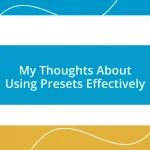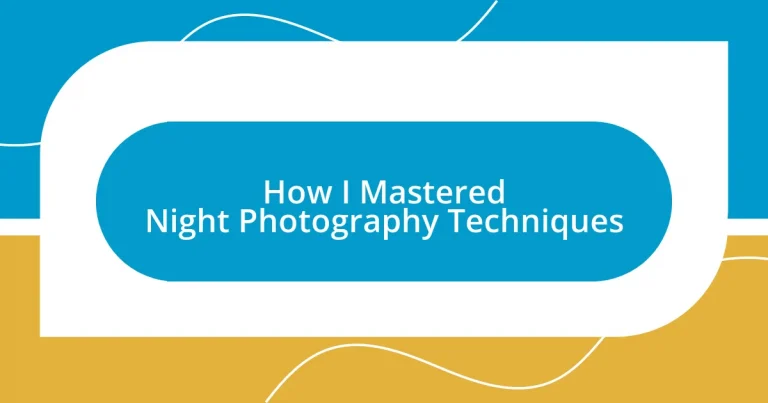Key takeaways:
- Understanding and adjusting camera settings—ISO, shutter speed, and aperture—are crucial for capturing beautiful night photographs.
- Investing in essential gear like a tripod, wide aperture lens, and remote shutter release can greatly improve the quality of night photography.
- Practical techniques such as using light trails, adjusting white balance, and incorporating foreground elements enhance the mood and depth of night shots.
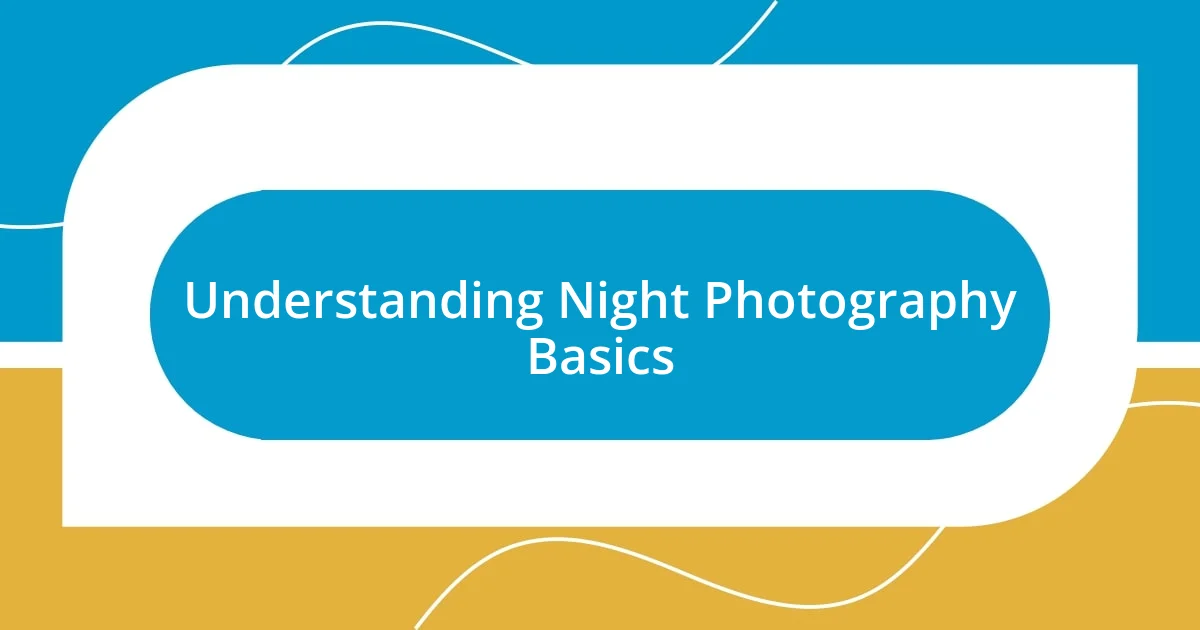
Understanding Night Photography Basics
Night photography can initially feel intimidating, but understanding its fundamental aspects is all about familiarity with your camera’s settings. I remember feeling a rush of excitement during my first night shoot, yet I found myself lost in a sea of buttons and dials. It’s all about learning to adjust your ISO, shutter speed, and aperture to bring out the beauty hidden in the dark.
When you’re shooting at night, you’ll soon discover that light is your greatest ally. I vividly recall a night in the city, when artificial lights transformed a mundane street into a vibrant canvas. Have you ever noticed how street lamps can create dramatic shadows and highlights? Embracing the available light can make all the difference in your photos.
Lastly, it’s essential to grasp the importance of composition in night photography. I learned this firsthand while trying to frame a gorgeous skyline under the stars. It sounds simple, but how do you balance the bright lights of the city with the subtle dimness of the sky? The interplay between these elements can lead to stunning results, capturing the essence of the moment beautifully.
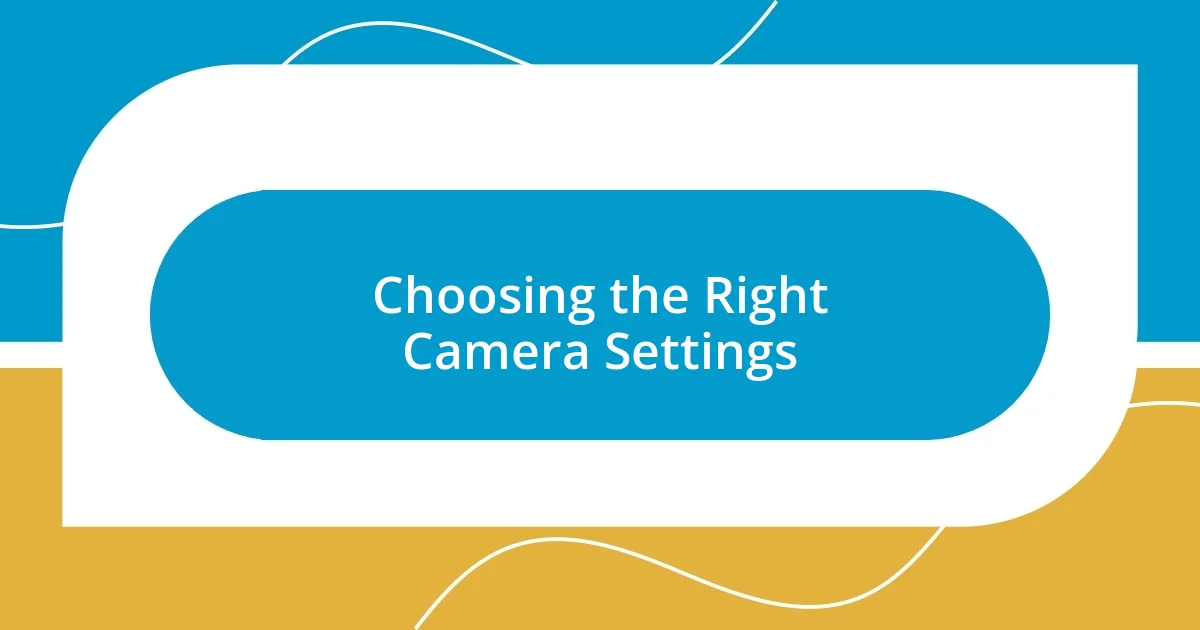
Choosing the Right Camera Settings
Choosing the right camera settings in night photography is crucial for capturing the magic of the nighttime world. From my experience, adjusting the ISO is often the first step. Increasing the ISO allows your camera to be more sensitive to light, but you’ve got to strike a balance—too high, and you’ll introduce noise, which can dull the vibrancy of your shot. I remember a night landscape I captured where I set my ISO too high, expecting to bring out the delicate star patterns. Instead, the noise made it look more like a grainy photograph rather than a celestial masterpiece.
When it comes to shutter speed, timing is everything. A longer exposure can illuminate more detail, but if there’s even the slightest movement—like a gentle breeze rustling the trees—you’ll end up with a blurred image. I learned this lesson the hard way during a twilight shoot when I let my excitement get the better of me. I set the shutter speed for too long while trying to capture fireworks; instead of a crisp display, I got a colorful blur. Now, I always assess for movement and stabilize my camera on a tripod whenever possible.
Aperture settings also play a significant role in night photography. A wider aperture (like f/2.8) can create beautiful bokeh effects while allowing more light in. However, I always remind myself of the depth of field this alters—it can isolate your subject beautifully or let too much of the scene go out of focus. A memorable evening was spent capturing cityscapes where I experimented with different apertures, and the results were striking. The moments spent adjusting these settings transformed my photos into stunning visual stories that truly reflect the magic of the night.
| Setting | Impact |
|---|---|
| ISO | Increases light sensitivity but may add noise if too high |
| Shutter Speed | Longer exposures bring out more detail, but risk motion blur |
| Aperture | Wider settings allow more light and create bokeh, impacting depth of field |
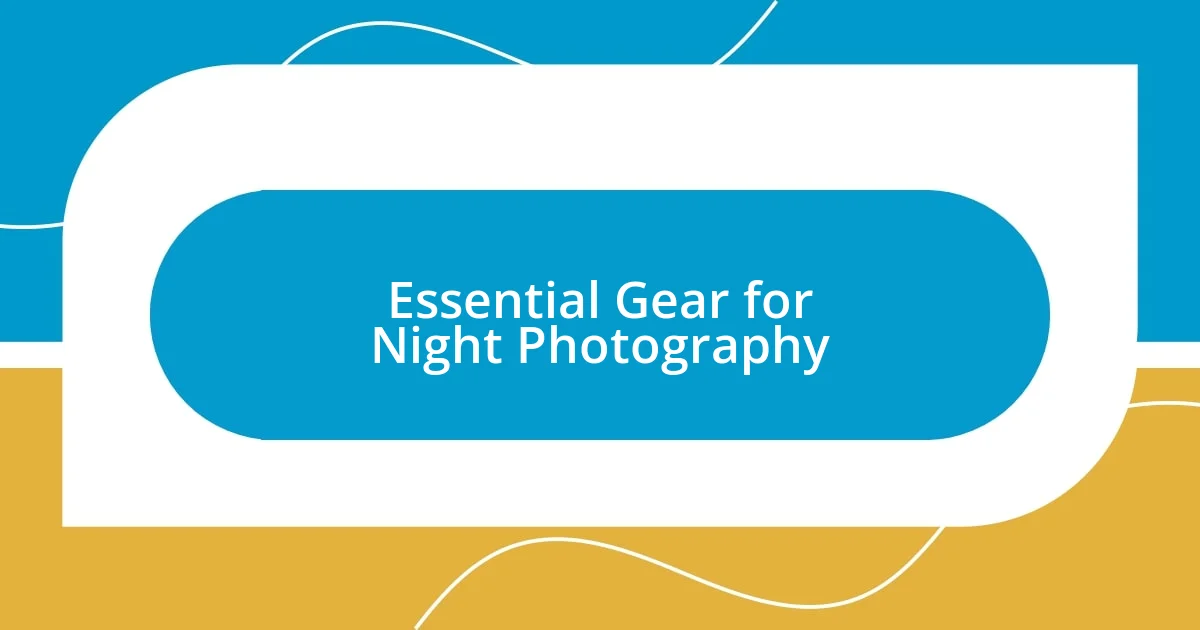
Essential Gear for Night Photography
When it comes to night photography, having the right gear can profoundly impact your results. I still remember my first night out, armed with nothing but a basic camera and a shaky hand. After a few frustrating attempts, I quickly realized that some essential equipment could drastically enhance my experience and outcomes.
Here’s a quick list of gear I found indispensable for shooting at night:
- Tripod: Essential for stabilizing your camera during long exposures. It frees you to focus on composition without worrying about shaky hands.
- Wide Aperture Lens: A lens that opens wide (like f/1.8 or f/2.8) allows more light in and helps create that stunning bokeh. I’ve captured some of my favorite portraits this way, with beautiful, soft backgrounds that really make the subject pop.
- Remote Shutter Release: Using this eliminates camera shake from pressing the shutter button. I can’t tell you how many times I ruined a perfect shot because my hand twitched just slightly!
- Flashlight or Headlamp: Not just for finding your way; a small light helps you adjust settings in the dark without fumbling around. Trust me, it can be a lifesaver when the adventure calls you into unfamiliar places.
- Extra Batteries: Cold weather can drain batteries quickly. I learned this the hard way when my camera shut down during a spectacular aurora display!
Building this kit transformed my night photography, turning frustration into fascination. Having the right tools made me feel more prepared to explore the dark landscapes that inspire me. It’s amazing how much confidence a few solid pieces of gear can give you!
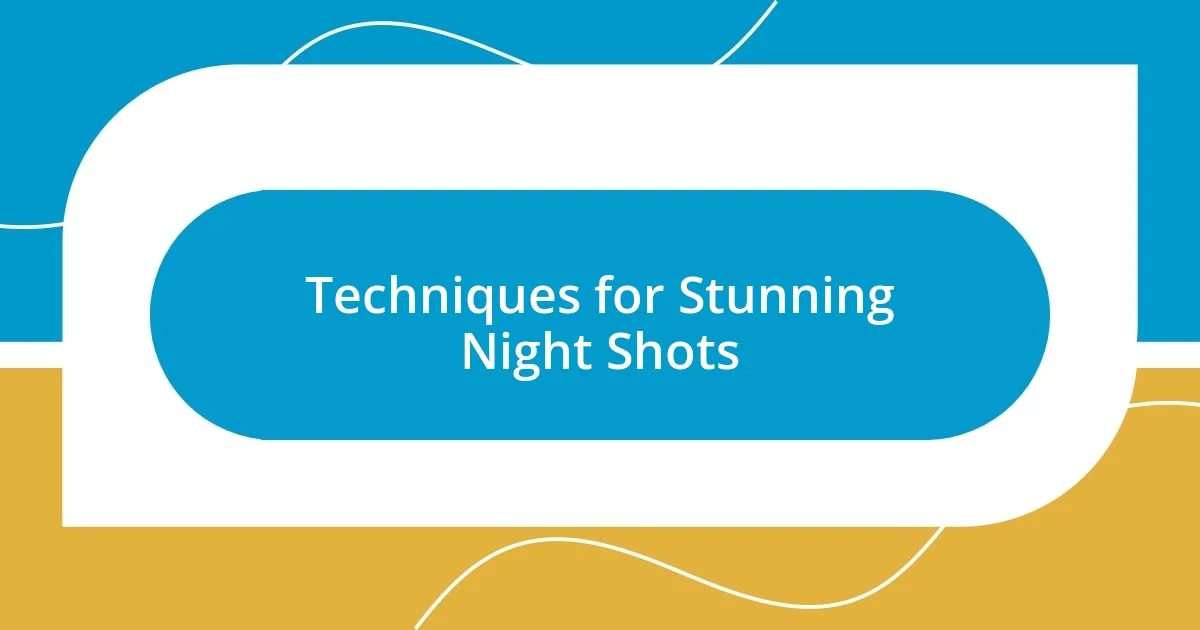
Techniques for Stunning Night Shots
Techniques for Stunning Night Shots
One of my favorite techniques for night photography is utilizing light trails. When shooting in urban environments, I find that capturing the movement of cars creates a stunning contrast against the nighttime backdrop. I remember one evening along a bustling street, I set my shutter speed to around 15 seconds. Watching those bright streaks of light dance across the frame was mesmerizing. It’s remarkable how a simple adjustment can turn an ordinary scene into a vibrant story.
Experimenting with white balance also makes a significant difference in the mood of your night shots. I once overlooked this aspect entirely, leaving me with a blue-hued photo that felt icy and lifeless. By adjusting the white balance to a warmer tone, I transformed a bland image of a lit-up bridge into a cozy, inviting scene that captured the warmth of the lights reflecting on the water. Have you tried tinkering with white balance for your night shots? You might be surprised by how a little tweak can evoke different emotions!
Another powerful technique is incorporating a foreground element to add depth to your photographs. I vividly recall a night at the beach, where I included a silhouette of a rock formation in the foreground while capturing the stars above. This simple addition created a sense of scale and drama that I hadn’t achieved in previous photos. It’s funny how a small change in perspective can elevate an image from a snapshot to a breathtaking piece of art. What elements can you use in your surroundings to give your night photos that extra punch?
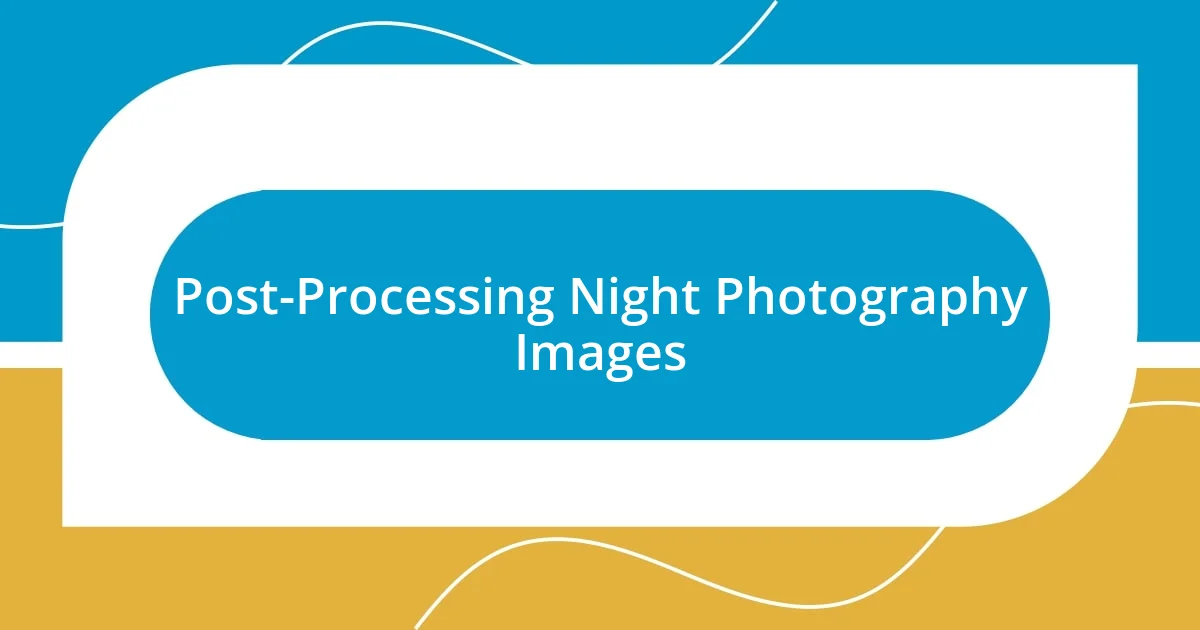
Post-Processing Night Photography Images
Post-processing night photography images can sometimes feel intimidating, but it’s where I’ve truly discovered the magic. I remember one night spent adjusting the vibrancy and contrast of a shot I took under the stars. After enhancing the colors, it was as if a veil had lifted, revealing a stunning blend of deep blues and vibrant whites that truly captured the night sky’s essence. Have you ever experienced that exhilarating moment when your edits transform a photo into something extraordinary?
I always use software like Adobe Lightroom for post-processing because it offers precise control over various elements. One technique I can’t recommend enough is adjusting the exposure. For instance, I had a night shot of a city skyline that looked overly dark. By raising the shadows slightly, I unveiled hidden details without losing that enchanting nighttime feel. This balance has been pivotal in making my images both striking and authentic. How do your adjustments change the story in your photos?
Moreover, sharpening details, especially in the stars or city lights, can elevate an image significantly. I recall a time when a friend’s feedback led me to experiment with clarity. I increased it just a notch on a photo of a lit-up bridge, and it was like a light switch flipped. The lights popped, making each element stand out beautifully, transforming it into a captivating focal point. I find that careful attention to these details during post-processing can bring out the narrative hidden beneath the surface of a night photograph. What little adjustments have you made that had a huge impact?
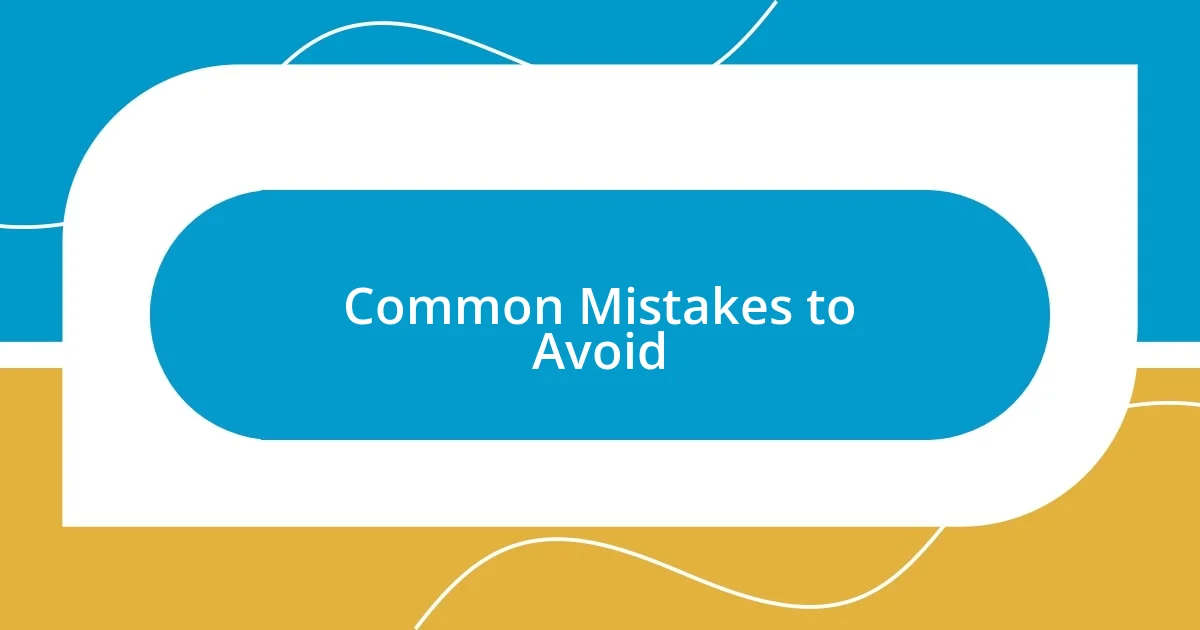
Common Mistakes to Avoid
One common mistake I often see when people are starting with night photography is underestimating the importance of stability. I’ve had my fair share of blurry images caused by even the slightest movement of the camera. Using a sturdy tripod changed everything for me; it allowed me to experiment with longer exposure times without the fear of losing sharpness. Have you ever tried shooting handheld in the dark? It can be frustrating!
Another pitfall is relying heavily on autofocus in low light. I remember one timeshooting a nighttime event and, in a rush, I left autofocus on. The result? A collection of out-of-focus shots that missed the magic of the moment. Switching to manual focus not only gave me more control but also allowed me to capture those fleeting expressions perfectly. How do you set your focus when the lights dim?
Lastly, neglecting to experiment with exposure settings can hinder your creativity. I once captured some incredible fireworks, but I fumbled with my settings, and most of the photos turned out overexposed. It taught me the value of playing around with aperture and ISO to find that sweet spot. Sometimes, the process of trial and error leads to the most rewarding discoveries, don’t you think?
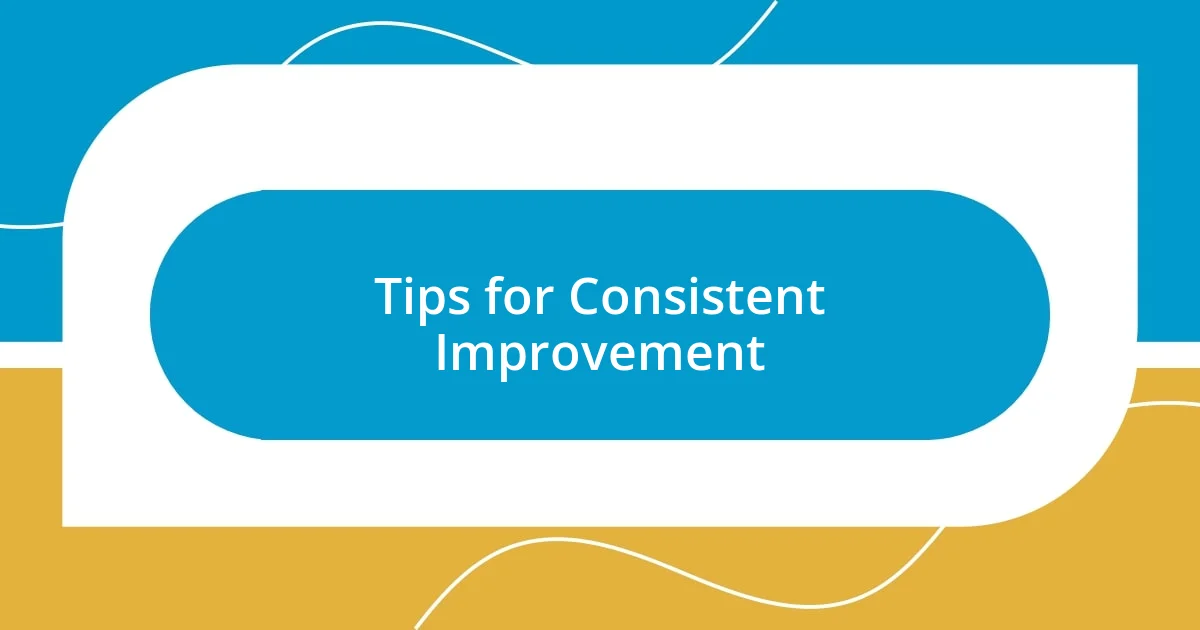
Tips for Consistent Improvement
Improving your night photography consistently boils down to practice and reflective learning. I remember a weekend I dedicated solely to capturing the night sky. I went out multiple nights in a row, trying different settings and compositions. Each session brought me closer to understanding what worked and what didn’t. How often do you revisit your favorite spots with new techniques in mind?
Feedback from my peers has been invaluable. After sharing my night shots in a photography group online, I received both praise and constructive criticism. One piece of advice that stood out was to pay attention to color temperature in nighttime shots. Adjusting this made a world of difference as it helped preserve the true beauty of the ambient light. Isn’t it amazing how others can see things in your work that you might miss?
Experimenting with new techniques can feel intimidating, yet it’s essential for growth. At one point, I tried light painting during a night shoot, which opened new creative avenues for me. The thrill of seeing those trails of light come to life in the final image was exhilarating. Have you dared to step outside your comfort zone, and if so, what discoveries did you make along the way?









